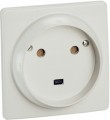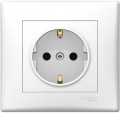In box
—
Socket (module assembly). The assembled module assumes the use of both an electrical contact group and a decorative panel (front frame). Some sockets are additionally equipped with a mounting box. Assembled sockets are completely ready for installation in a mounting box. Electrical fittings of this type are convenient in that when choosing it, there is no need to separately select the front decorative panel.
—
Socket without a frame. Sockets without a frame are equipped with an electrical contact group and a front decorative panel, and the user must order the front decorative frame separately. Usually, frameless sockets are ordered when certain requirements are imposed on the design of electrical fittings. Thus, the customer has the opportunity to choose the version of the front panel that will most successfully harmonize with the interior of the room where the socket will be mounted. Manufacturers of frameless sockets also offer a wide range of individual faceplates that are fully compatible with the electrical contact group.
—
Mechanism only. The socket is represented only by an electrocontact group and is devoid of a front decorative panel. This option is more suitable for cases where the user already has a front panel that is fully compatible with the design of the electrocontact group. Some socket manufacturers offer a wide selection of front de
...corative panels for their products, so you can choose various lining options for a separately sold electrical contact group. In this case, the user has the choice of which decorative panel to install on the socket so that its design matches the interior of the room.Rated current
The current strength of the outlet determines how powerful the equipment it can power. A standard
16 A household outlet allows you to safely service equipment up to 3.52 kW. The maximum power of consumers is calculated by the formula: network voltage (220 V) * socket current.
In the past, standard household outlets used an amperage rating of 6.3 A. But over time, more electrical appliances have been used in homes, forcing manufacturers to raise the standard amperage rating. If you connect a splitter (carrying device) to a 16 A socket that serves equipment with a total power of over 3.52 kW, the socket may melt.
Sockets with a rated current of 25 and 32 A are intended for installation in production and industrial facilities. Typically they use a 3-phase 380 V network.
Maximum power
The value of the maximum power of the outlet determines the total power of consumers that are powered from it.
This parameter is inextricably linked with the rated current of the outlet. So, an ordinary household socket with a rated current of 16 A is capable of servicing equipment with a power of up to 3.52 kW. The maximum power is determined by the formula: voltage (230 V) * rated current. So, for example, W = 220 * 16 = 3520 W. If more powerful equipment is connected to an outlet with a maximum power of 3.52 kW, the outlet will melt.
Embedding depth
The insertion depth of the socket must correspond to the depth of the mounting box. Usually, the standard installation depth is 40 mm. But there are models with both smaller and larger installation depths. For example, narrow sockets require only 25 mm depth from the back box. Additionally, there is a series of sockets that require at least 60 or even 80 mm depth from the mounting box.
Frame thickness
This parameter is applicable to built-in electrical fittings. The thickness of the frame determines how much the outlet will protrude from the wall. In the average model, this figure is in the range of 7-10 mm. The thinner the frame, the more neat the socket will look.

